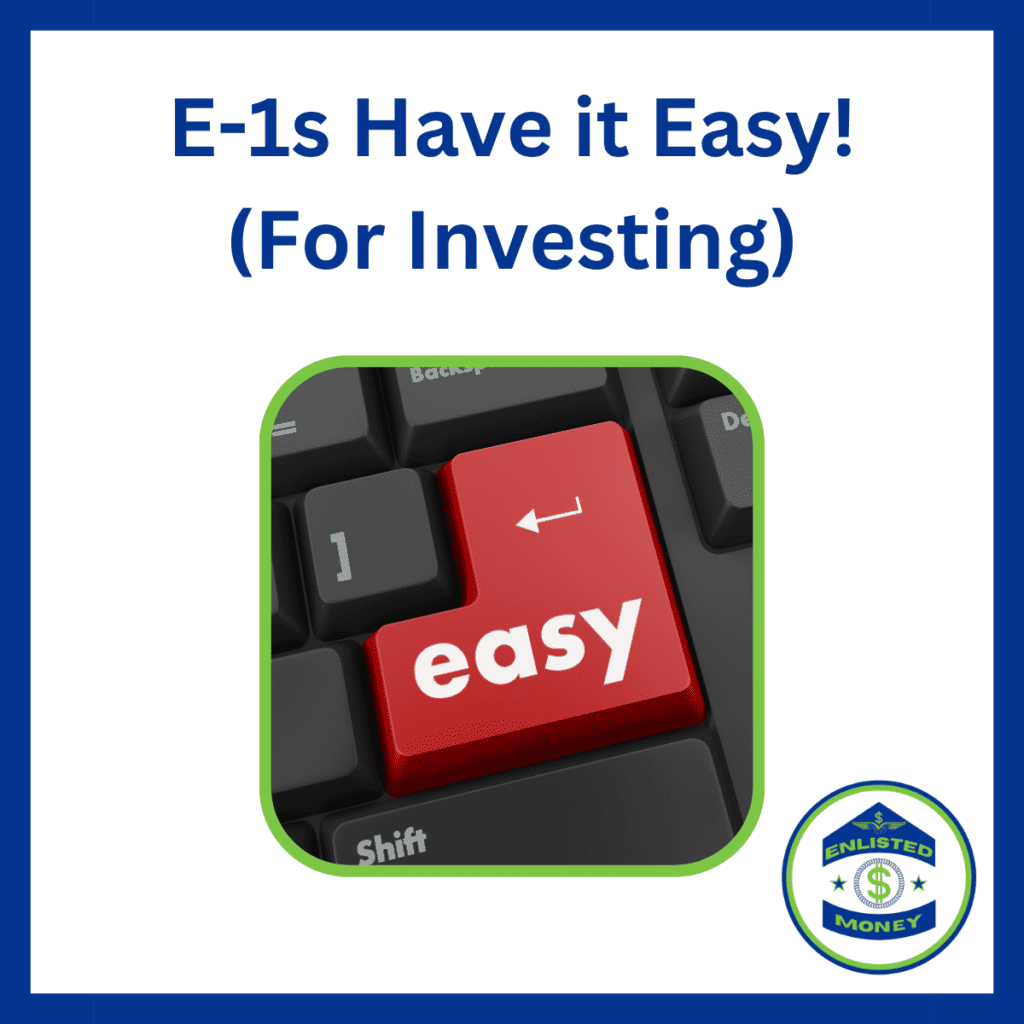
You’ll never have it easier as an enlisted investor than when you’re an E-1. Why? Time. Time is on your side my friend!
If I could go back in time, I’d tell my 18-year-old self to invest more into my TSP from day one. I’d also told myself, “You’ll be a millionaire if you put 10% into your TSP and never stop!”. That would have been $145 per month as a newly minted E-3 in 2005.
What Does it Take to Become a Millionaire as an E-1?
It takes astonishingly little to reach $1 Million in assets if you just start early. I can remember showing one of my Soldiers this a few years back. He only needed to put in about $150 a month to reach the same amount in his accounts as me putting in over $700 a month – just because I started late.
If you want to be a millionaire, all you have to do is put $242.691 into your TSP (or other retirement account) every month until you turn 60. Too easy, right? Well, that’s roughly 13% of your base pay2 as a new service member. This probably feels like, well, a lot of money right now.
Change Your Perspective
I want to point out a couple things to put everything in perspective. If your base pay is $1917.60 per month and you put 13% into your retirement accounts each month, when you turn 60 you can start withdrawing money at a 4% rate to give you $40,000 a year in income. That’s 174% of your current annual base pay. You have to save a whole lot less now than if you wait until later.
Think about what saving that money actually provides you – freedom. If you’re like me, you get really tired of being told what to do – especially if it’s something really dumb or repetitive. I mean, how many times do we need to lay all our equipment out, wait for the commander to not show up, and put it back away?
A Quick Caveat
I hear this all the time (and you probably have too), “You have everything paid for and no bills, you should be doing __ with your money.” I really hate it when people, who don’t understand my life, try to “should” me into doing anything. It’s my money, I get to choose what to do with it. I’d imagine young service members feel this a lot too.
It’s not my intent to “should” anyone. I just wish someone would have spelled everything out for me so I could better understand the opportunity I was missing at the time. I wish one of my leaders would have kindly sat me down and had a conversation about how I could become a millionaire with what I was spending on cigarettes and Monster energy drinks a month (I’ve quit both, btw).
It’s my sincerest hope that if you’re a young, enlisted service member reading this, you’ll imagine I’m talking to you in the kindest and most caring way possible. It’s your money, you can choose to do with it. You’re my brother or sister in arms and I want you to be even more successful than I was. I hope you can learn from my mistakes and be a wonderful success story for others to follow in the future.
Now back to becoming a millionaire.
The Cost of Waiting
Now let’s suppose you decide you “can’t afford” to save 13% into your TSP right now. You decide to wait until you’ve been in a while and get established. If you wait 2 years until you’re an E-4 (welcome to the E-4 Mafia!), you’ll miss out on a ton of growth.
If you started 2 years in, you’d have to put in roughly 9% of your base pay3 to be at the same level of investment. However, if you invested this amount, you’ll end up with $173,189.71 less when you turn 60-years-old! Can you afford to make a $173,189.71 mistake? Yeah, me neither.
Bottom Line, you really can’t afford not to start investing now.
My Own Mistakes
If I’d started when I was a young, 18-year-old Private First Class (E-3 in the Army), every extra percent into my TSP would have grown by 387.65%, or 9.48% per year! In other words, for every 1% I put in ($14.56), it would have grown to $71 by now. And that’s just over the course of the last 18 years. If you take that out to when I’ll turn age 60, I cost myself an estimated $9,221.35 for each percentage point I didn’t contribute!
If I’d just contributed 13% and never contributed any more than the initial amount, I would have $107,153.52 in my TSP account right now. Which if it grows at 8% (lower than actual returns), would grow to $726,247.50. Bottom line, I’m almost certain I’d be a millionaire already if I’d done what I’m explaining to you now.
Playing Catch-Up
I’m “playing catch-up” now and making good progress, but I could have contributed a lot less over my career and ended up with a whole lot more. The power of time invested is truly awesome!
If you’re reading this and you’ve already been in a while, yes, you may have missed out on some opportunities. However, there’s nothing you can do about that now. Just start where you’re at and share what you’ve learned with your teammates so they can get started too.
For our youngest team members, it gets even better. For a young E-1 today, it’s a whole lot easier to build wealth than when I started.
E-1s Have it Easy (for Investing)
With the new Blended Retirement System (BRS), a young service member can build wealth even easier than I can. There are tradeoffs of course, like only 40% of base pay versus 50% for a 20-year retirement. However, most folks aren’t going to retire from the military after 20 years. I think it’s a great system – if you take full advantage of it.
Matching Contributions
The biggest advantage of the BRS is your ability to get matching TSP contributions. After 60 days in service, you’re supposed to start getting a 1% match automatically. This will show up on your LES in the “YTD TSP AGCY-AUTO” block toward the bottom right.
After 2 years in service, you’ll be eligible for the full match of 1% for the first three percent you contribute and then one half (0.5%) match for the next two percent. To keep it simple, you get the full 5% match if you contribute 5%. This will show up on your LES in the “YTD TSP AGCY-MATCH” block in the bottom right.
It’s Free Money!
I can’t stress this enough, don’t lose out on getting free money from your match! How else can you get an automatic, guaranteed 100% return on your money? It’s like if you handed me $250 and then I immediately deposited $500 into your TSP – pretty awesome!
Looking at it differently, each month you don’t contribute enough to get your match, it’s like losing $250 (probably more) each month! Would you want to pay an extra $250 a month in rent or your phone bill? Nope, I didn’t think so.
Automatic Enrollment
As a new service member, you should be automatically enrolled in the traditional TSP at 5%. Your money will be invested in the Lifecycle fund closest to when you’ll hit your “full retirement age” which is currently age 67. You can change both of these options using MyPay and the TSP website.
Personally, for most service members, you should change your contributions to go into the Roth TSP. There are some circumstances where you might want to temporarily contribute to the traditional TSP. Currently, all your matching contributions will be deposited into your traditional TSP account.
It’s fine to leave your TSP invested in the Lifecycle fund. This will automatically adjust over time.
Your Biggest Advantage as a New Service Member
The biggest thing you have going for you as a new service member is time. Each month you wait is money lost. You don’t get paid a lot, so don’t lose even more money by waiting to invest.
I know your 60’s seem a long way away, but you will never regret investing earlier. If you go above and beyond the minimums we talked about, it’s entirely possible you’ll be able to be a millionaire and/or financially independent even sooner.
Save More Later
I totally understand if putting 13% or more into your TSP seems like a lot. If you have a young family, this may even seem impossible. At a minimum, you have to contribute enough to get your match. That’s free money!
My suggestion is to use the “save more later” plan. I was introduced to this idea by the book, Nudge. In short, you just increase your TSP contributions gradually over time.
Gradual Increases
If I could go back in time, I would set my TSP percentage as high as I could stand, probably 10% or so. Then I would bump up my contributions by 1% each time I got a pay raise for time in service increases or promotions until I was maxing it out. If I’d done this, I’d never have noticed that money was missing.
I’d be contributing an additional 15% from where I started (10 annual/bi-annual TIS increases and 5 promotions) for a current total of 25%. Even if you start at 5% and then just bump up your contributions from there, you’re going to be way better off. Just please, pretty please, never contribute less than 5% to get the match!
Take Advantage of Bonuses and Deployments
I also wish I’d taken advantage of my bonuses and deployments to pay off debt and contribute even more. For some enlisted service members, you might be able to stuff close to $100,000 or more into your TSP in your very first enlistment. This alone would be enough to make you a millionaire5 in the future.
I can only imagine what my account would look like if I invested my initial enlistment bonus of $5,000 and combat pay (15 months’ worth) during my first enlistment. You can set your pay up to have a portion (or all) of your bonuses contributed to your TSP. These are real opportunities for you to supercharge your investment for the future.
One Last Request
I sincerely hope this article has been helpful. I just have one last request. Please, make sure you’re saving for the future. If you can stay out of debt, invest wisely, and increase your pay and contributions over time, you’ll be in so much better shape than where I am.
If you’d like to get more content like this and get more behind-the-scenes, personal updates, subscribe to the Enlisted Investor Newsletter. You’ll be the first to access new content, help me decide what content I write about, and be eligible for giveaways.
1Assumes 8% annual rate of return for 40 years. The S&P 500 (the same stocks as the C-Fund) has had returns of 9.97% annually over the last 30 years; this would require only $138.61 per month to achieve an account balance of $1,000,000 at age 60 if you start contributing at age 18.
2Based on E-1 pay in 2023 with more than 4 months’ time in service (TIS). 13% into your TSP would be $249.29.
3Based on E-4 pay in 2023 with over 2 years’ TIS, 9% would be $236.84 per month.
4Based on 2005 base pay of $1,456.20, for 1 year and then stopping, calculated until 2023.
5Calcualted at 8% compounded annually for 29.9 years.
